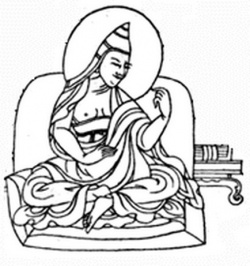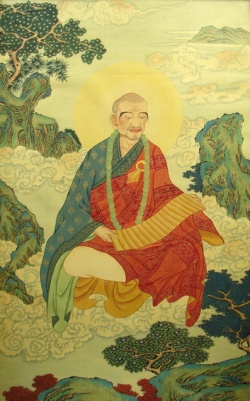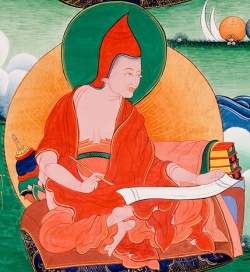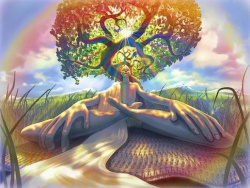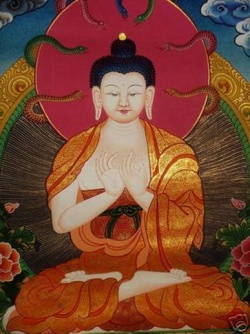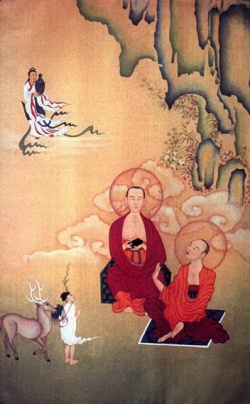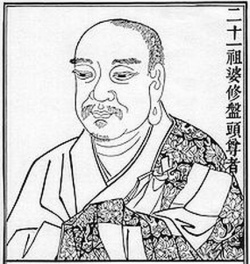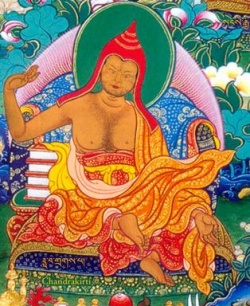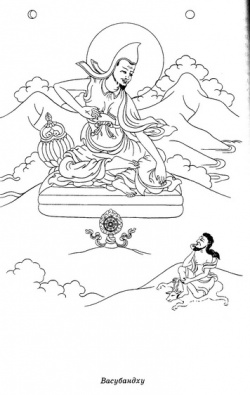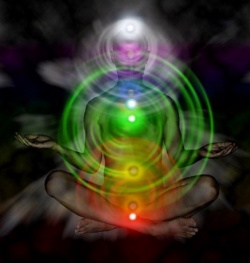Trimsatika (Thirty Verses) of Vasubandhu
1
Everything that is taken as a self;
Everything that is taken as other:
These are simply changing forms of consciousness.
2
Pure consciousness transforms itself
Into three modes: Store consciousness,
Thought consciousness, and active consciousness.
3
The store consciousness holds the seeds of all past experience.
Within it are the forms of grasping
And the dwelling places of the unknown.
It always arises with touch, awareness, recognition, concept, and desire.
4
The store consciousness is clear and undefinable.
Like a great river, it is always changing.
Neither pleasant nor unpleasant, when one becomes fully realized, it ceases to exist.
5
The second transformation of consciousness is called thinking consciousness.
It evolves by taking the store consciousness as object and support.
Its essential nature is to generate thoughts.
6
The thinking consciousness
Is always obscured by four defilements:
Self-regard, self-delusion, self-pride, and self-love.
7
The thinking consciousness also arises with the mental factors
Of touch, awareness, recognition, concept, and desire.
This consciousness ceases when one becomes realized.
It also falls away when consciousness is impaired,
And when one is fully present.
8
The third transformation of consciousness
Is the active perception of sense objects.
These can be good, bad, or indifferent in character.
9
This active consciousness arises with three kinds of mental functions: Those that are universal, those that are specific, and those that are beneficial.
It is also associated with primary and secondary defilements
And the three kinds of feeling.
10
The universal factors are touch, awareness, recognition, concept, and desire.
The specific factors are intention, resolve, memory, concentrationd knowledge.
The beneficial factors are faith, modesty, respect, distance, courage, composure, equanimity, alertness, and compassion.
11
The primary defilements are:
Passion, aggression, ignorance,
Pride, intolerance, and doubt.
12
The secondary defilements are:
Anger, hatred, jealousy,
Envy, spite, hypocrisy, deceit…
13
Dishonesty, arrogance, harmfulness,
Immodesty, lack of integrity, sluggishness,
Restlessness, lack of faith, laziness, idleness,
Forgetfulness, carelessness, and distraction.
14
Remorse, sleepiness, reasoning, and analysis
Are factors which can be either defiled or undefiled.
15
The five sense consciousnesses arise in the store consciousness
Together or separately, depending on causes and conditions,
Just like waves arise in water.
16
Thought consciousness manifests at all times,
Except for those born in the realms of beings without thought,
Those in the formless trances, and those who are unconscious.
17
These three transformations of consciousness
Are just the distinction of subject and object, self and other–
They do not really exist.
All things are nothing but forms of consciousness.
18
Since the storehouse consciousness contains all seeds,
These transformations of consciousness arise
And proceed based upon mutual influence.
On account of this, discrimination of self and other arises,
19
All actions leave traces,
And because of grasping at self and other,
Once one seed has been exhausted, another arises.
20
That which is differentiated
In terms of self and other,
Or by whatever sort of discrimination,
That is just mental projection:
It does not exist at all
21
Appearances themselves
Which arise dependently through causes and conditions
Exist, but only in a partial and dependent way.
22
Ultimately, perfect nature, the fully real, arises
When there is an absence of mental projection onto appearances.
For that reason, the fully real is neither the same nor different from appearances.
If the perfected nature is not seen, the dependent nature is not seen either.
23
Corresponding to the threefold nature,
There is a threefold absence of self-nature.
This absence of self-nature of all dharmas
Is the secret essence of the Buddha’s teachings.
24
Projections are without self-nature by definition.
Appearances too are without self-nature because they are not
self-existent.
Perfect nature is without any differentiation whatsoever.
25
The true nature of consciousness only
Is the true nature of all dharmas.
Remaining as it is at all times, it is Suchness.
26
As long as consciousness does not see
That subject-object distinctions are simply forms of consciousness
Attachment to twofold grasping will never cease
27
By merely thinking
The objects one perceives are forms of consciousness
One does not realize consciousness only
28
One realizes consciousness only
When the mind no longer seizes on any object
When there is nothing to be grasped, there is no grasping
Then one knows – everything is consciousness only.
29
That is the supreme, world-transcending knowledge
Where one has no mind that knows
And no object that is known
Abandoning twofold grasping
The storehouse consciousness is emptied
30
That alone is the pure, primordial reality
Beyond thought, auspicious, unchanging
It is the blissful body of liberation
The dharmakaya nature of the enlightened ones
Adapted from English translations of the Sanskrit original
